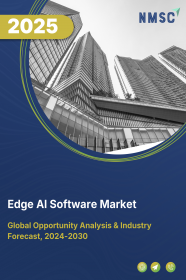
Edge AI Software Market by Component (Solutions and Services), by Data Source (Video & Image Recognition, Speech Recognition, Biometric Data, Sensor Data, and Mobile Data), by Application (Autonomous Vehicles, Access Management, Video Surveillance, Remote Monitoring & Predictive Maintenance, Energy Management, and Others), and by End-Users (Manufacturing, Automotive, Telecom, Healthcare, Government & Public, and Others) - Global Opportunity Analysis and Industry Forecast 2024-2030
Market Definition
The global Edge AI Software Market size was valued at USD 1.27 Billion in 2023 and is predicted to reach USD 9.1 Billion by 2030 with a CAGR of 32.6% from 2024-2030. Edge AI, also known as Edge Artificial Intelligence, refers to the deployment and execution of artificial intelligence (AI) algorithms directly on edge devices or local hardware, closer to the data source and without relying on centralized cloud computing resources. In this approach, AI processing occurs at the "edge" of the network, where data is generated, collected, and often requires real-time or near-real-time analysis and decision-making.
By performing AI computations locally, edge AI aims to reduce latency, enhance privacy, save bandwidth, and enable faster responses in applications ranging from Internet of Things (IoT) devices, autonomous vehicles, industrial automation, healthcare devices, and more. Edge AI software empowers devices to perform intelligent tasks without relying on constant connectivity to the cloud, making it suitable for scenarios where low latency and high efficiency are critical.
Market Dynamics and Trends
The demand for edge AI software is increasing due to the rising adoption of internet of things (IoT) devices such as smart home devices, wearables, and industrial sensors. According to Ericsson, a multinational networking and telecommunications company, broadband IoT (4G/5G) reached 1 billion connections in 2021, overtaking 2G and 3G as the technology that connects the largest share of all cellular IoT devices. Edge AI allows real-time processing & analysis of data generated by IoT devices, without the need to constantly transmit data to a central location.
Also, edge AI software is cost-effective compared to cloud-based AI solutions and is much faster and requires fewer resources, which is further boosting the growth the market. Moreover, the increasing demand for real-time data processing and analysis in industries such as manufacturing, healthcare, and transportation is fueling the market growth. Edge AI enables data to be processed at or near the source, reducing the need to transmit large amounts of data to a centralized location, which can improve data transmission speed and reduce latency.
However, high initial investments in hardware, software, and skilled personnel can be the factors deterring smaller enterprises from adopting edge AI and restrain the growth of the market. On the other hand, the introduction of visual recognition and neural network pruning is expected to create ample growth opportunities for the / Edge AI market in the future. These technologies have the potential to significantly improve the performance and efficiency of Edge AI systems.
Market Segmentation and Scope of Study
The global edge AI software market report is segmented on the basis of component, data source, application, end-user, and geography. Based on component, the market is classified into solutions and services. Solution is further sub divided into, software tools and platform. Services are further subdivided into, training & consultation service, system integration & testing service, and support & maintenance services. Based on the data source, the market is segmented into video and image recognition, speech recognition, biometric data, sensor data, and mobile data.
On the basis of application, the market is categorized into autonomous vehicles, access management, video surveillance, remote monitoring & predictive maintenance, energy management, and others. On the basis of end-user, the market is divided into manufacturing, automotive, telecom, healthcare, government & public, and others. Geographical breakdown and analysis of each of the aforesaid classifications include regions comprising of North America, Europe, Asia-Pacific, and RoW.
Geographical Analysis
North America dominates the global edge AI software market and is expected to remain dominant in the market throughout the forecast period. This is attributed to the rising demand for autonomous vehicles along with research and development for AVs in the region. Edge AI technology is crucial for real-time decision-making and data processing in autonomous vehicles.
According to reports published by the National News in December 2022, tech giant Apple is working on a project named ‘Project Titan’ with an aim to develop a fully autonomous electric vehicle, which is expected to launch by the year 2026. The growth of the edge AI market in the region is being further propelled by the active participation of major market players like Microsoft Corporation, IBM Corporation, Google LLC, and Cloudera.
Their strategic initiatives, such as product launches and collaborations, are contributing significantly to this positive trend. For instance, in November 2022, IBM launched new software designed to help enterprises break down data and analytics silos to provide quick data-driven solutions and navigate unpredictable disruptions.
Also, in April 2021, Cloudera, announced the integration of the Cloudera Data Platform (CDP) with the RAPIDS Accelerator for Apache Spark 3.0. deployed on NVIDIA computing platforms. The software enables enterprises to drive faster AI adoption and deliver better business outcomes, without changing any code.
On the other hand, Asia Pacific shows substantial growth in the global edge AI software market owing to the rising adoption of IoT and smart devices in healthcare sector along with the growing infrastructure of healthcare in developing countries such as India and South Korea.
For instance, in June 2022, The World Bank Board of Executive Directors approved two complementary loans of USD 500 million each to support and enhance India’s health sector. This combined USD 1 billion financing is aimed to support India’s flagship Pradhan Mantri-Ayushman Bharat Health Infrastructure Mission (PM-ABHIM), launched in October 2021 and also to improve the public healthcare infrastructure across the country.
Thus, the increased investment in healthcare infrastructure in the Asia Pacific region leads to the adoption of advanced technology in the medical sector, which in turn is driving growth in the market in the region. Also, the rapid development in 5G network in countries such as China, South Korea and India is further accelerating the edge AI software market growth.
For instance, in August 2022, China Mobile allocated a substantial investment of USD 8.7 billion towards advancing the 5G network infrastructure within the nation. This decision was influenced by the growing number of 5G subscribers in China, which surged to 263 million in the year 2022.
Competitive Landscape
The edge AI software industry includes several market players such as IBM Corporation, Microsoft Corporation, Intel Inc., Google LLC, TIBCO, Cloudera, Nutanix, Amazon Web Services, Dell Technologies, Cisco Systems, NVIDIA Corporation, Hewlett Packard Enterprise, VMware, Synaptics, Xilinx, Inc.. This innovative platform aims to leverage edge AI and advanced technologies to optimize supply chain processes. This launch highlights the role of edge AI software in transforming supply chain operations, enhancing efficiency, and promoting sustainability.
Moreover, in October 2021, Google Cloud launched Google distributed cloud allowing customers to leverage over 140+ Google network edge locations around the world. Furthermore, in May 2020, IBM launched new services and solutions backed by a broad ecosystem of partners to help enterprises and telecommunications companies speed their transition to edge computing in the 5G era.
Key Benefits
-
The report provides quantitative analysis and estimations of the edge AI market from 2023 to 2030, which assists in identifying the prevailing market opportunities.
-
The study comprises a deep-dive analysis of the edge AI market including the current and future trends to depict prevalent investment pockets in the market.
-
Information related to key drivers, restraints, and opportunities and their impact on the global market is provided in the report.
-
Competitive analysis of the players, along with their market share is provided in the report.
-
SWOT analysis and Porters Five Forces model is elaborated in the study.
-
Value chain analysis in the market study provides a clear picture of roles of stakeholders.
Edge AI Market Key Segments
By Component
-
Solutions
-
Software Tools
-
Platform
-
-
Services
-
Training & Consultation Services
-
System Integration & Testing Services
-
Support & Maintenance Services
-
By Data Source
-
Video & Image Recognition
-
Speech Recognition
-
Biometric Data
-
Sensor Data
-
Mobile Data
By Application
-
Autonomous Vehicles
-
Access Management
-
Video Surveillance
-
Remote Monitoring & Predictive Maintenance
-
Energy Management
-
Others
By End-User
-
Manufacturing
-
Automotive
-
Telecom
-
Healthcare
-
Government & Public
-
Others
By Geography
-
North America
-
The U.S.
-
Canada
-
Mexico
-
-
Europe
-
The UK
-
Germany
-
France
-
Italy
-
Spain
-
Denmark
-
Netherlands
-
Finland
-
Sweden
-
Norway
-
Russia
-
Rest of Europe
-
-
Asia-Pacific
-
China
-
Japan
-
India
-
South Korea
-
Australia
-
Indonesia
-
Singapore
-
Taiwan
-
Thailand
-
Rest of Asia-Pacific
-
-
RoW
-
Latin America
-
Middle East
-
Africa
-
Key Players
-
IBM Corporation
-
Microsoft Corporation
-
Intel Inc.
-
Google LLC
-
TIBCO
-
Cloudera
-
Nutanix
-
Amazon Web Services
-
Dell Technologies
-
Cisco Systems
-
NVIDIA Corporation
-
Hewlett Packard Enterprise
-
VMware
-
Synaptics
-
Xilinx, Inc.
Report Scope and Segmentation
|
Parameters |
Details |
|
Market Size in 2022 |
USD 1.27 Billion |
|
Revenue Forecast in 2030 |
USD 9.1 Billion |
|
Growth Rate |
CAGR of 32.6% from 2023 to 2030 |
|
Analysis Period |
2023–2030 |
|
Base Year Considered |
2023 |
|
Forecast Period |
2024–2030 |
|
Market Size Estimation |
Billion (USD) |
|
Growth Factors |
Rising adoption of IoT devices in businesses Cost effectiveness of edge AI software compared to cloud-based AI solutions Growing demand for real-time data processing and analysis in industries |
|
Countries Covered |
28 |
|
Companies Profiled |
15 |
|
Market Share |
Available for 10 companies |
|
Customization Scope |
Free customization (equivalent up to 80 working hours of analysts) after purchase. Addition or alteration to country, regional, and segment scope. |
|
Pricing and Purchase Options |
Avail customized purchase options to meet your exact research needs. |




















 Speak to Our Analyst
Speak to Our Analyst

























